Christian Koeder's Blog
September 9, 2020
Vans "old skool pro BMX Dennis Enarson OLIVE/GUM" are leather-free
In the good and proper vegan skate shoe desert that is this world, some people who don't like to use leather might resort to a "BMX shoe".
In addition to some all canvas versions of the "old skool" shoe - and some versions that are all canvas EXCEPT the Vans strip that is actual real leather - Vans has an all synthetic colourway of an "old skool pro BMX", namely the "(Dennis Enarson) olive/gum" colourway.
This shoe "features the revolutionary WAFFLECUP BMX construction. Specifically designed with the BMXer in mind, WAFFLECUP BMX construction provides unrivaled support and durability without having to sacrifice precious pedalfeel, including DURACAP upper reinforcement. A herringbone underlayer adds a second life beneath Vans' classic gum rubber compound that has a more rigid flex pattern-all reinforced like a tank. Designed, tested, and approved by today's top riders, the Old Skool Pro BMX is made with synthetic leather uppers."
As I know nothing about BMX, I would assume the mid-section of the shoe sole needs reinforcement. Not sure if this works for skateboarding.
Here's what the shoes look like:
Vans "old skool pro BMX Dennis Enarson olive gum"





Being naturally curious, I also googled "Vans" and "Donald Trump". I couldn't find anything extremely incriminating (within 2 minutes) but I found this (2019):
"A Vans retail employee in Overland Park, Kan., has been fired after he allegedly cursed at a 14-year-old customer wearing a red “Make America Great Again” hat (popularized by President Donald Trump).
The teen boy was shopping with his family when the unnamed store employee muttered “F**ck you” to him. The encounter was caught on camera and uploaded to social media on Feb. 17. The child’s mother can be seen on video swiftly responding to the employee with, “He did nothing to you. What did you say to my son? To my 14-year-old son?”
The employee then said, “I’m sure he’s heard it before.” The outraged woman asks to speak to the store’s manager. “My son walked into this store. That gentleman cursed and told him, ‘Take off your hat.’ [My son] said nothing to him, [and] then he said, ‘F you’ to my son. My son said nothing to him, did nothing,” she is heard telling the manager before the video — which has now been viewed thousands of times online — ends."
A good enough reason not to buy Vans maybe.
Published on September 09, 2020 11:57
August 23, 2020
Alimentación crudivegana
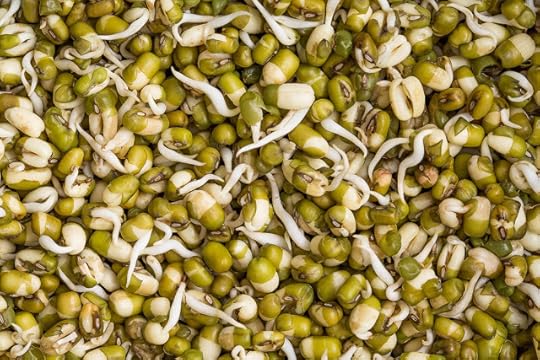
El argumento más fuerte en contra de una dieta de alimentos 100% crudos es la falta de argumentos convincentes para este tipo de dieta.
En primer lugar, es importante señalar que hay muchos tipos diferentes de dietas crudas: las dietas de 100% alimentos crudos o las dietas con la mayoría de los alimentos crudos, las dietas crudas veganas ("crudiveganas"), crudas y ovo-lacto-vegetarianas o crudas y no vegetarianas, las dietas crudas basadas en frutas o basadas en brotes. Las dietas crudas pueden incluir o excluir las legumbres (brotes de legumbres), los cereales/granos (brotes), los frutos secos, las semillas, los aceites prensados en frío, los zumos/jugos prensados en frío, las especias, las frutas secas, etc.
El siguiente texto sólo se refiere a las dietas crudas veganas.
Muchas de las ideas seobre una alimentación sana que todavía están muy extendidas hoy en día, incluyendo la idea de que una dieta completamente crudivegana sería la dieta más "natural" han existido durante más de 100 años. Esto incluye la idea de que los cereales/granos y las legumbres no serían unos alimentos saludables. Lo que se asume es que hay algo como la "dieta natural para el organismo humano" y que esta "dieta perfecta" a la vez es la forma de alimentarse más saludable para todos los humanos. Si uno sigue estas ideas (no probadas) de que una dieta crudivegana es "la dieta natural" y, por lo tanto, decide comer sólo frutas, verduras, frutos secos y semillas, es probable que el resultado sea una ingesta subóptima hasta insuficiente de ciertos nutrientes. Además, esto se puede evitarse si se planifica bien la dieta crudivegana.
Nutrientes a tener en cuenta y posibles fuentes de alimentos/suplementos (ver también mis Recomendaciones para veganos):
Vitamina B12: tomar un suplemento (1-4) (ver el enlace arriba)Proteínas (especialmente el aminoácido lisina, pero también una ingesta de proteínas suficiente en términos de cantidad de proteínas): comer grandes cantidades de brotes de legumbres (brotes de judías mungo, por ejemplo) y tal vez utilizar un polvo de proteína crudo. Las cantidades muy grandes de los jugos verdes también pueden aportar cantidades bastante relevantes de proteínas (5).Calcio: consumir agua rica en calcio, verduras de hoja verde (ricas en calcio, bajas en ácido oxálico; ver el enlace arriba), y posiblemente usar un suplemento (~300 mg por día) (6)Vitamina D: tomar mucho sol (6) (muchos de los que se dedican a la alimentación cruda lo hacen, en realidad) y/o tomar un suplemento (ver el enlace arriba)Yodo: consumir algas marinas como nori o wakame, usar sal yodada (no sal marina, sal del Himalaya, etc.), o tomar un suplemento que contenga yodo (ver el enlace arriba)Ácidos grasos omega-3: buenas fuentes son, por ejemplo, las nueces, las semillas de lino (linaza), las semillas de cáñamo, las semillas de chía, etc. (ver el enlace arriba)Hierro y zinc: consumir grandes cantidades de legumbres y brotes de cereales (y también de verduras verdes, frutos secos semillas diariamente)Selenio: comer una nuez de Brasil (o dos) cada día (ver enlace arriba)Provitamina A: consumir jugo de zanahoria o jugo de verduras de hoja verde (7) o muchas frutas de color naranja, como mangos y papayas (ver el enlace arriba)
En el caso de ciertos alimentos se puede recomendar consumirlos preferencialmente en su forma cruda: especialmente las frutas así como los aceites prensados en frío, especialmente los aceites prensados en frío altamente insaturados como el aceite de lino (linaza).
Ciertos nutrientes se absorben más efectivamente de los alimentos cocidos, como el licopeno (de los tomates) y el betacaroteno (provitamina A) (7, 8).
Cocinar y hacer pan con levadura o masa madre mejora la absorción de minerales, como el hierro y el zinc, de los cereales.
Ciertos alimentos NO deben consumirse de forma cruda. Entre ellos son las judías rojas, la mandioca (yuca), los brotes de bambú y (idealmente) los champiñones.
Un alto consumo de fruta fresca puede dañar el esmalte de los dientes debido a los ácidos de las frutas ácidas y al azúcar de la fruta que puede adherirse a los dientes. Se recomienda una pasta de dientes que contenga fluoruro (flúor) y practicar una buena higiene oral (9-11). No se debería cepillar los dientes inmediatamente después de comer alimentos ácidos, como las naranjas o las toronjas (los pomelos). Más bien enjuaga tu boca con agua antes de cepillarte los dientes.
Cabe señalar que las "fases de desintoxicación" ("pasar por la desintoxicación") que se describen a menudo en la literatura sobre las dietas crudas suelen reflejar deficiencias de nutrientes. Es decir, si te sientes débil y enfermo después de seguir una dieta 100% crudivegana, no es porque te estés "desintoxicando" sino porque tu cuerpo no está recibiendo suficientes nutrientes. Esto puede ser beneficioso durante períodos de tiempo muy cortos, como un día de ayuno, pero no durante largos períodos de tiempo.
Los síntomas típicos de una grave insuficiencia de peso, por ejemplo, son la reducción de la masa muscular, de la fuerza muscular y de la densidad ósea, la ausencia de menstruación (amenorrea) (12), una alta sensibilidad al frío y un sistema inmunológico débil.
Para los atletas que muchas veces tienen una ingesta muy alta de alimentos y calorías probablemente es más fácil obtener cantidades suficientes de los micronutrientes (de alimentos no enriquecidos) con una dieta 100% crudivegana, en comparación con los que no son atletas (13). Esto no se aplica a la vitamina B12 o la vitamina D, que normalmente están prácticamente ausentes en los alimentos vegetales no enriquecidos.
Una dieta crudivegana, como otras dietas saludables, puede ayudar a las personas a perder el exceso de peso corporal, lo que también tendrá efectos beneficiosos para la salud de las arterias (2, 14, 15).
Es muy importante señalar que una dieta 100% cruda o predominantemente cruda no es adecuada para los bebés y los niños pequeños, ya que su volumen estomacal es pequeño, lo que dificulta que obtengan suficientes nutrientes con una dieta crudivegana.
En caso de enfermedades graves, no se debe bajo ninguna circunstancia confiar solo en la "naturalidad" y el "poder de curación" de una dieta cruda curarse. En cambio, se debería planificar bien una dieta crudivegana. En el caso de los niños, esto significa que el contenido de fibra (16) de la dieta debe ser sólo moderado, y en el caso de todas las personas esto significa que debe garantizarse una ingesta suficiente de calorías y de los nutrientes mencionados arriba. En los niños, se debe controlar bien su crecimiento y desarrollo mental y físico saludable (17). En Inglaterra, los Estados Unidos y Alemania (y otros países) se han producido casos aislados de bebés que han muerto como resultado de algunas formas de dietas crudiveganas: por ejemplo, una dieta que consistía principalmente en frutas, verduras y frutos secos o una dieta de jugo de hierba de trigo, agua de coco y leche de almendras casera o una dieta de principalmente leche de almendras y leche de coco casera (18). La lección que hay que aprender de estos casos no es que una dieta crudivegana deba ser terrible en todas las circunstancias, sino que una mezcla de "fe en la naturaleza", una dieta cruda y un rechazo total de los suplementos y de la medicina moderna puede ser una "receta mortal" (17).
En efecto, algunas críticas a los sistemas de salud actuales están justificadas, entre ellas la ausencia casi total de algunos de los factores más importantes que influyen en la salud, a saber, la dieta y el estilo de vida, de la practica de la medicina hoy en día, la influencia de la codicia personal, la egomanía de algunos médicos y las actitudes anticientíficas que prevalecen en el área de la medicina, así como la influencia de las empresas farmacéuticas en la práctica de la medicina y también en la investigación científica. Pero un rechazo total de la medicina moderna también puede ser muy peligroso.
Incluso antes de que el Homo sapiens existiera, nuestros antepasados usaban el fuego para cocinar sus alimentos. No hay nada que sugiera que nuestra especie se haya adaptado a una dieta específica en el curso de la evolución, y que esta dieta sea entonces la más saludable. A diferencia de las especulaciones salvajes sobre la evolución humana, la epidemiología nutricional de hoy en día (la parte de la ciencia de nutrición centrada en el efecto de la dieta en la salud) proporciona fuertes evidencias científicas que indican que una alimentación basada en las plantas, quiere decir, a base de frutas, verduras, legumbres, cereales integrales, frutos secos, semillas y aceites saludables, promueve la buena salud, el bienestar y la longevidad (19, 20).
Para aquellos con interés en una alimentación crudivegana se puede recomendar el libro "Becoming raw" de las nutricionistas veganas canadienses Vesanto Melina y Brenda Davis (21).
Referencias1. Yunatskaya TA, Turchaninova NS, Kostina NN. Hygienic assessment of nutrition in vegetarians and people with mixed feeding. Gig Sanit 2015; 94:72–5.
2. Koebnick C, Garcia AL, Dagnelie PC, Strassner C, Lindemans J, Katz N, Leitzmann C, Hoffmann I. Long-term consumption of a raw food diet is associated with favorable serum LDL cholesterol and triglycerides but also with elevated plasma homocysteine and low serum HDL cholesterol in humans. J Nutr 2005; doi:10.1093/jn/135.10.2372.
3. Hobbs SH. Attitudes, practices, and beliefs of individuals consuming a raw foods diet. Explore (NY) 2005; doi:10.1016/j.explore.2005.04.015.
4. Donaldson MS. Metabolic vitamin B12 status on a mostly raw vegan diet with follow-up using tablets, nutritional yeast, or probiotic supplements. Ann Nutr Metab 2000; doi:10.1159/000046689.
5. Cheeke R. Vegan bodybuilding and fitness. The complete guide to building your body on a plant-based diet. Healthy Living; Publishers Group UK [distributor]: Summertown, Tenn., Enfield, 2011.
6. Fontana L, Shew JL, Holloszy JO, Villareal DT. Low bone mass in subjects on a long-term raw vegetarian diet. Arch Intern Med 2005; doi:10.1001/archinte.165.6.684.
7. Garcia AL, Mohan R, Koebnick C, Bub A, Heuer T, Strassner C, Groeneveld MJ, Katz N, Elmadfa I, Leitzmann C, et al. Plasma beta-carotene is not a suitable biomarker of fruit and vegetable intake in german subjects with a long-term high consumption of fruits and vegetables. Ann Nutr Metab 2010; doi:10.1159/000262295.
8. Garcia AL, Koebnick C, Dagnelie PC, Strassner C, Elmadfa I, Katz N, Leitzmann C, Hoffmann I. Long-term strict raw food diet is associated with favourable plasma beta-carotene and low plasma lycopene concentrations in Germans. Br J Nutr 2008; doi:10.1017/S0007114507868486.
9. Strużycka I, Rusyan E, Bogusławska-Kapała A. Erozje zębów - problem interdyscyplinarny. [Tooth erosion - a multidisciplinary approach]. Pol Merkur Lekarski 2016; 40:79–83.
10. Ganss C, Schlechtriemen M, Klimek J. Dental erosions in subjects living on a raw food diet. Caries Res 1999; doi:10.1159/000016498.
11. O'Toole S, Bernabé E, Moazzez R, Bartlett D. Timing of dietary acid intake and erosive tooth wear: A case-control study. J Dent 2017; doi:10.1016/j.jdent.2016.11.005.
12. Koebnick C, Strassner C, Hoffmann I, Leitzmann C. Consequences of a long-term raw food diet on body weight and menstruation: results of a questionnaire survey. Ann Nutr Metab 1999; doi:10.1159/000012770.
13. Leischik R, Spelsberg N. Vegan triple-ironman (raw vegetables/fruits). Case Rep Cardiol 2014; doi:10.1155/2014/317246.
14. Fontana L, Meyer TE, Klein S, Holloszy JO. Long-term low-calorie low-protein vegan diet and endurance exercise are associated with low cardiometabolic risk. Rejuvenation Res 2007; doi:10.1089/rej.2006.0529.
15. Douglass JM, Rasgon IM, Fleiss PM, Schmidt RD, Peters SN, Abelmann EA. Effects of a raw food diet on hypertension and obesity. South Med J 1985; doi:10.1097/00007611-198507000-00017.
16. Amoroso S, Scarpa M-G, Poropat F, Giorgi R, Murru FM, Barbi E. Acute small bowel obstruction in a child with a strict raw vegan diet. Arch Dis Child 2019; doi:10.1136/archdischild-2018-314910.
17. Cundiff DK, Harris W. Case report of 5 siblings: malnutrition? Rickets? DiGeorge syndrome? Developmental delay? Nutr J 2006; doi:10.1186/1475-2891-5-1.
18. Koeder C. Veganismus. Für die Befreiung der Tiere. 1. Auflage. Koeder: Ellwangen, 2014.
19. Willett W, Rockström J, Loken B, Springmann M, Lang T, Vermeulen S, Garnett T, Tilman D, DeClerck F, Wood A, et al. Food in the Anthropocene: the EAT–Lancet Commission on healthy diets from sustainable food systems. The Lancet 2019; doi:10.1016/S0140-6736(18)31788-4.
20. Satija A, Hu FB. Plant-based diets and cardiovascular health. Trends Cardiovasc Med 2018; doi:10.1016/j.tcm.2018.02.004.
21. Davis B, Melina V, Berry R. Becoming raw. The essential guide to raw vegan diets. Book Publishing Company: Summertown, Tennessee, 2010.
Published on August 23, 2020 07:11
Rohkosternährung

Das stärkste Argument gegen eine komplette Rohkosternährung ist das Fehlen von überzeugenden Argumenten für eine solche Ernährungsweise. Zuerst ist es wichtig festzustellen, dass es viele verschiedene Arten von Rohkosternährung gibt: ausschließliche oder hauptsächliche Rohkost, vegane, ovo-lacto-vegetarische oder nicht-vegetarische, Obst-basierte oder Sprossen-basierte oder Rohkostformen mit oder ohne Hülsenfrüchte, Getreide, Nüsse, Öle, Säfte, Gewürze etc. Im Folgenden soll es nur um vegane Rohkosternährungsweisen gehen.
Heute noch weit verbreitete Ideen, u. a., dass eine reine Rohkosternährung die „natürlichste“ Ernährungsweise sei, dass sie deshalb die gesündeste sei und dass Getreide und Hülsenfrüchte eigentlich suboptimale Lebensmittel wären, kamen schon vor weit über 100 Jahren Ideen vor. Wenn man diesen (unbewiesenen) Ideen folgt und sich ausschließlich von Obst, Gemüse, Nüssen und Samenkernen ernährt, ist es wahrscheinlich, dass es zu einer suboptimalen bis unzureichenden Zufuhr bestimmter Nährstoffe kommt – was durch gute Planung aber vermieden werden kann.
Zu beachtende Nährstoffe und mögliche Quellen (siehe auch die Empfehlungen für Veganer):
Vitamin B12: Supplemente (1–4)Protein (insbesondere die Aminosäure Lysin, aber auch mengenmäßig ausreichend Protein): große Mengen Hülsenfruchtsprossen und rohes Proteinpulver und evtl. sehr große Mengen grüner Säfte (5)Kalzium: kalziumreiches Wasser, grüne Blattgemüse (kalziumreich, oxalsäurearm), evtl. ein Supplement (6)Vitamin D: Sonnenschein (6) oder ein SupplementJod: Algen, Jodsalz oder ein SupplementOmega-3-Fettsäuren: z. B. Walnüsse, Leinsamen, Hanfsamen, ChiasamenEisen und Zink: große Mengen Hülsenfrucht- und GetreidesprossenSelen: kleine Mengen ParanüsseProvitamin A: Säfte aus Karotten oder grünem Blattgemüse (7)
Bestimmte Lebensmittel sind im Allgemeinen in roher Form empfehlenswerter – insbesondere Obst und kaltgepresste Öle (besonders stark ungesättigte kaltgepresste Öle wie Leinöl). Bestimmte Nährstoffe werden aus gekochten Lebensmitteln besser absorbiert, z. B. Lycopen (aus Tomaten) und Betacarotin (Provitamin A) (7, 8). Kochen sowie die Brotherstellung mit Hefe oder Sauerteig verbessern die Absorption von Mineralien wie Eisen und Zink aus Getreide. Nicht roh verzehrt werden sollten u. a. Kidneybohnen und kleine rote Bohnen, Maniok (Cassava), Bambussprossen und (idealerweise) Pilze. Ein hoher Obstverzehr kann durch Obstsäuren und Fruchtzucker den Zahnschmelz angreifen – fluoridhaltige Zahncreme und eine gute Mundhygiene sind empfehlenswert (9–11). (Man sollte nicht direkt nach dem Essen von säurehaltigen Lebensmitteln - z. B. Orangen oder Grapefruits - die Zähne putzen, sondern vorher den Mund mit Wasser ausspülen.)
Zu beachten ist, dass in der Rohkostliteratur vielfach beschriebene „Entgiftungsphasen“ (Detox) oft tatsächlich Nährstoffmängel widerspiegeln. Typische Symptome starken Untergewichts sind z. B. eine reduzierte Muskelmasse, Muskelkraft und Knochendichte, das Ausbleiben der Menstruation (Amenorrhö) (12), eine hohe Kälteempfindlichkeit und ein geschwächtes Immunsystem.
Für Sportler, die sehr hohe Kalorienmengen zuführen, ist es wahrscheinlich einfacher, mit Rohkosternährung ausreichende Mengen von Mikronährstoffen (aus nicht-angereicherten Lebensmitteln) zuzuführen (13) – dies gilt nicht für Vitamin B12 oder Vitamin D.
Eine Rohkosternährung kann – wie andere gesunde Ernährungsformen – dabei helfen überschüssiges Körpergewicht zu verlieren und damit einhergehend die Gesundheit der Arterien zu verbessern (2, 14, 15).
Besonders beachtenswert ist, dass Rohkosternährung für Babys und Kleinkinder ungeeignet ist, da deren Magenvolumen klein ist, was eine ausreichende Nährstoffzufuhr erschwert. Auf keinen Fall sollte man sich bei Erkrankungen auf die (geglaubte) „Natürlichkeit“ und die damit einhergehende (erwünschte) „Heilkraft“ einer Rohkosternährung verlassen. Stattdessen sollte die Ernährung sehr gut geplant werden (bei Kindern: moderater Ballaststoffgehalt (16)) und eine ausreichende Zufuhr an Kalorien und den oben genannten Nährstoffen muss sichergestellt werden. Bei Kindern muss das Wachstum und die geistige und körperliche Entwicklung gut überwacht werden (17). Unter anderem in England, den USA und Deutschland gab es einzelne Fälle von Babys oder Kleinkindern, die infolge bestimmter Rohkosternährungsformen starben – eine Ernährung bestehend aus hauptsächlich Obst, Gemüse und Nüssen oder aus hauptsächlich Weizengrassaft, Kokosnusswasser und selbstgemachter Mandelmilch bzw. aus hauptsächlich selbstgemachter Mandel- und Kokosmilch (18). Die Lektion aus diesen Fällen ist nicht, dass eine Rohkosternährung unter allen Umständen schlecht sein muss, sondern dass eine Mischung aus Naturglauben, Rohkosternährung und einer völligen Ablehnung von Supplementen und moderner Medizin ein tödliches Rezept sein können (17). (Eine gewisse Kritik an den gegenwärtigen Gesundheitssystemen, u. a. dem Fehlen der gewichtigsten Einflussfaktoren auf die Gesundheit, nämlich Ernährung und Lebensstil, und an der Art und Weise, wie Medizin oft praktiziert wird, ist durchaus berechtigt. Aber ein komplettes Ablehnen der modernen Medizin kann ebenfalls sehr gefährlich sein.)
Schon bevor es den Homo sapiens gab, verwendeten unsere Vorfahren Feuer und kochten ihre Nahrung. Nichts deutet darauf hin, dass sich unsere Spezies im Laufe der Evolution an eine ganz bestimmte Ernährungsform angepasst hätte – und dass diese Ernährungsweise dann die gesündeste wäre. Anders als wilde Spekulationen über die Evolutionsgeschichte liefert die heutige Ernährungsepidemiologie eine starke wissenschaftliche Evidenz dafür, dass ein pflanzenbasiertes Ernährungsmuster, basierend auf Obst, Gemüse, Hülsenfrüchten, Vollkorngetreide, Nüssen und gesunden Ölen die Gesundheit fördert (19, 20).
An Rohkost Interessierten ist besonders das Buch von Vesanto Melina und Brenda Davis „Becoming raw“ zu empfehlen (21).
Quellenangaben1. Yunatskaya TA, Turchaninova NS, Kostina NN. Hygienic assessment of nutrition in vegetarians and people with mixed feeding. Gig Sanit 2015; 94:72–5.
2. Koebnick C, Garcia AL, Dagnelie PC, Strassner C, Lindemans J, Katz N, Leitzmann C, Hoffmann I. Long-term consumption of a raw food diet is associated with favorable serum LDL cholesterol and triglycerides but also with elevated plasma homocysteine and low serum HDL cholesterol in humans. J Nutr 2005; doi:10.1093/jn/135.10.2372.
3. Hobbs SH. Attitudes, practices, and beliefs of individuals consuming a raw foods diet. Explore (NY) 2005; doi:10.1016/j.explore.2005.04.015.
4. Donaldson MS. Metabolic vitamin B12 status on a mostly raw vegan diet with follow-up using tablets, nutritional yeast, or probiotic supplements. Ann Nutr Metab 2000; doi:10.1159/000046689.
5. Cheeke R. Vegan bodybuilding and fitness. The complete guide to building your body on a plant-based diet. Healthy Living; Publishers Group UK [distributor]: Summertown, Tenn., Enfield, 2011.
6. Fontana L, Shew JL, Holloszy JO, Villareal DT. Low bone mass in subjects on a long-term raw vegetarian diet. Arch Intern Med 2005; doi:10.1001/archinte.165.6.684.
7. Garcia AL, Mohan R, Koebnick C, Bub A, Heuer T, Strassner C, Groeneveld MJ, Katz N, Elmadfa I, Leitzmann C, et al. Plasma beta-carotene is not a suitable biomarker of fruit and vegetable intake in german subjects with a long-term high consumption of fruits and vegetables. Ann Nutr Metab 2010; doi:10.1159/000262295.
8. Garcia AL, Koebnick C, Dagnelie PC, Strassner C, Elmadfa I, Katz N, Leitzmann C, Hoffmann I. Long-term strict raw food diet is associated with favourable plasma beta-carotene and low plasma lycopene concentrations in Germans. Br J Nutr 2008; doi:10.1017/S0007114507868486.
9. Strużycka I, Rusyan E, Bogusławska-Kapała A. Erozje zębów - problem interdyscyplinarny. [Tooth erosion - a multidisciplinary approach]. Pol Merkur Lekarski 2016; 40:79–83.
10. Ganss C, Schlechtriemen M, Klimek J. Dental erosions in subjects living on a raw food diet. Caries Res 1999; doi:10.1159/000016498.
11. O'Toole S, Bernabé E, Moazzez R, Bartlett D. Timing of dietary acid intake and erosive tooth wear: A case-control study. J Dent 2017; doi:10.1016/j.jdent.2016.11.005.
12. Koebnick C, Strassner C, Hoffmann I, Leitzmann C. Consequences of a long-term raw food diet on body weight and menstruation: results of a questionnaire survey. Ann Nutr Metab 1999; doi:10.1159/000012770.
13. Leischik R, Spelsberg N. Vegan triple-ironman (raw vegetables/fruits). Case Rep Cardiol 2014; doi:10.1155/2014/317246.
14. Fontana L, Meyer TE, Klein S, Holloszy JO. Long-term low-calorie low-protein vegan diet and endurance exercise are associated with low cardiometabolic risk. Rejuvenation Res 2007; doi:10.1089/rej.2006.0529.
15. Douglass JM, Rasgon IM, Fleiss PM, Schmidt RD, Peters SN, Abelmann EA. Effects of a raw food diet on hypertension and obesity. South Med J 1985; doi:10.1097/00007611-198507000-00017.
16. Amoroso S, Scarpa M-G, Poropat F, Giorgi R, Murru FM, Barbi E. Acute small bowel obstruction in a child with a strict raw vegan diet. Arch Dis Child 2019; doi:10.1136/archdischild-2018-314910.
17. Cundiff DK, Harris W. Case report of 5 siblings: malnutrition? Rickets? DiGeorge syndrome? Developmental delay? Nutr J 2006; doi:10.1186/1475-2891-5-1.
18. Koeder C. Veganismus. Für die Befreiung der Tiere. 1. Auflage. Koeder: Ellwangen, 2014.
19. Willett W, Rockström J, Loken B, Springmann M, Lang T, Vermeulen S, Garnett T, Tilman D, DeClerck F, Wood A, et al. Food in the Anthropocene: the EAT–Lancet Commission on healthy diets from sustainable food systems. The Lancet 2019; doi:10.1016/S0140-6736(18)31788-4.
20. Satija A, Hu FB. Plant-based diets and cardiovascular health. Trends Cardiovasc Med 2018; doi:10.1016/j.tcm.2018.02.004.
21. Davis B, Melina V, Berry R. Becoming raw. The essential guide to raw vegan diets. Book Publishing Company: Summertown, Tennessee, 2010.
Published on August 23, 2020 07:10
Raw food diets
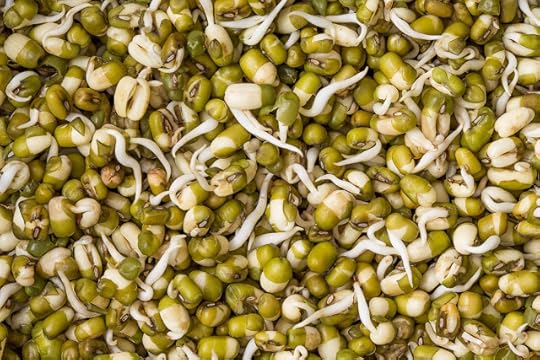
The strongest argument against a 100% raw food diet is the lack of any convincing arguments for such a way of eating.
First, it is important to note that there are many different types of raw food diets: 100% raw or mainly raw food diets, vegan, ovo-lacto-vegetarian, or non-vegetarian raw food diets, fruit-based or sprout-based or raw food diets, and raw foods diets that include or exclude legumes (legume sprouts), grains (sprouts), nuts, cold-pressed oils, cold-pressed juices, spices, etc.
The following text only deals with vegan raw food diets.
Many ideas that are still widespread today, including the idea that a completely raw vegan diet would be the most "natural" diet, and that grains and legumes are not healthy foods, have been around for well over 100 years. What is (and has been) assumed here is there is something like the "natural diet for the human organism" and that this "perfect diet" is also the healthiest diet for all humans. If one follows these (unproven) ideas of a raw vegan diet being "the natural diet" and therefore decides to eat only fruit, vegetables, nuts and seeds, it is likely that the result will be a suboptimal to insufficient intake of certain nutrients - but this can be avoided if the raw vegan diet is well-planned.
Nutrients to consider and possible food/supplement sources (also see my Nutrient recommendations for vegans):
Vitamin B12: take a supplement (1-4) (see link above)Protein (especially the amino acid lysine but also just a sufficient protein intake in terms of protein quantity): eat large amounts of legume sprouts (mung bean sprouts, for example) and maybe use a raw protein powder. Very large amounts of green juices can also contribute quite relevant amounts of protein (5).Calcium: consume calcium-rich water, green leafy vegetables (rich in calcium, low in oxalic acid), and possibly use a supplement (~300 mg per day) (6)Vitamin D: get a lot of sunshine (6) (many raw foodist do, actually) and/or take a supplement (see link above)Iodine: consume seaweed like nori or wakame, use iodized salt (not sea salt, Himalaya salt, etc.), or take an iodine-containing supplement (see link above)Omega-3 fatty acids: good sources are, for example, walnuts, flaxseeds/linseeds, hemp seeds, chia seeds, etc. (see link above)Iron and zinc: consume large quantities of legume and grain sprouts (and also green vegetables, nuts, and seeds daily)Selenium: eat a Brazil nut per day (or two) (see link above)Provitamin A: consume carrot juice or green leafy vegetable juice (7) or plenty of orange-coloured fruits like mangos and papayas (see link above)
With certain foods it can be recommended to preferentially consume them in their raw form: especially fruit as well as cold-pressed oils, particularly highly unsaturated cold-pressed oils such as flaxseed/linseed oil. Certain nutrients are more readily absorbed from cooked foods, such as lycopene (from tomatoes) and beta-carotene (provitamin A) (7, 8). Cooking and bread making with yeast or sourdough improves the absorption of minerals such as iron and zinc from cereals. Certain foods should NOT be eaten raw (uncooked). These include kidney beans and small red beans, cassava, bamboo shoots and (ideally) mushrooms. A high intake of fresh fruit can damage your tooth enamel because of the acids in acidic fruit and because of the sugar in fruit which can stick to your teeth. A fluoride-containing toothpaste and practicing good oral hygiene is recommended (9-11). Do not brush your teeth immediately after eating acidic foods such as oranges or grapefruits. Rather rinse your mouth with water before brushing your teeth.
It should be noted that "detoxification phases" ("going through detox") which is often described in the raw food literature usually reflects nutrient deficiencies. That is, if you feel weak and ill after getting on a 100% raw vegan diet, it is not because you are "detoxing" but because your body is not getting enough nutrients. This may be beneficial for very short periods of time - as in fasting - but not for long periods of time. Typical symptoms of severe underweight, for example, are reduced muscle mass, muscle strength, and bone density, the absence of menstruation (amenorrhoea) (12), a high sensitivity to cold, and a weak immune system.
For athletes who have a very high intake of food and calories it is probably easier to get sufficient amounts of micronutrients (from non-fortified foods) with a 100% raw food diet compared to non-athletes (13) - but this does not apply to vitamin B12 or vitamin D, which are typically practically absent from non-fortified plant foods.
A raw diet, like other healthy diets, can help people to lose excess body weight, which will also result in beneficial effects for artery health (2, 14, 15).
It is particularly important to note that a 100% or predominatly raw food diet is not suitable for babies and toddlers, as their stomach volume is small, which makes it difficult for them to get enough nutrients on a raw diet. In the case of illness, you should under no circumstance rely on the (believed) "naturalness" and the associated (desired) "healing power" of a raw food diet to cure yourself. Instead, a raw food diet should be very well planned. For children this means that the fibre content (16) of the diet should only be moderate, and for everyone this means that a sufficient intake of calories and the above-mentioned nutrients must be ensured. In children, their growth and mental and physical development must be well monitored (17). In England, the United States, and Germany (and other countries) there have been isolated cases of babies or infants dying as a result of particular raw food diets: for example, a diet consisting mainly of fruit, vegetables, and nuts or a diet of mainly wheatgrass juice, coconut water, and homemade almond milk or a diet of mainly homemade almond milk and coconut milk (18). The lesson to be learned from these cases is not that a raw food diet must be terrible under all circumstances but that a mixture of "nature faith", a raw food diet and a complete rejection of supplements and modern medicine can be a deadly recipe (17). Some criticism of current health systems is indeed justified, including the near complete absence of some of the most important factors which influence health, namely diet and lifestyle, from the way medicine is often practiced today, the influence of personal greed, egomania, and anti-science attitudes prevalent in medicine as well as the influence of pharmaceutical corporations on medical practice but also scientific research. But a complete rejection of modern medicine can also be very dangerous.
Even before Homo sapiens existed, our ancestors used fire to cook their food. There is nothing to suggest that our species has adapted to a specific dietary pattern over the course of evolution - and that this diet would then be the healthiest one. Unlike wild speculation about human evolution, modern day nutritional epidemiology (nutrition science focused on the effect of diet on health) provides strong scientific evidence which indicates that a plant-based dietary pattern, based on fruit, vegetables, legumes, whole grains, nuts, seeds, and healthy oils, promotes good health, well-being, and longevity (19, 20).
For those interested in raw foods, the book "Becoming raw" by Vesanto Melina and Brenda Davis is highly recommended (21).
References1. Yunatskaya TA, Turchaninova NS, Kostina NN. Hygienic assessment of nutrition in vegetarians and people with mixed feeding. Gig Sanit 2015; 94:72–5.
2. Koebnick C, Garcia AL, Dagnelie PC, Strassner C, Lindemans J, Katz N, Leitzmann C, Hoffmann I. Long-term consumption of a raw food diet is associated with favorable serum LDL cholesterol and triglycerides but also with elevated plasma homocysteine and low serum HDL cholesterol in humans. J Nutr 2005; doi:10.1093/jn/135.10.2372.
3. Hobbs SH. Attitudes, practices, and beliefs of individuals consuming a raw foods diet. Explore (NY) 2005; doi:10.1016/j.explore.2005.04.015.
4. Donaldson MS. Metabolic vitamin B12 status on a mostly raw vegan diet with follow-up using tablets, nutritional yeast, or probiotic supplements. Ann Nutr Metab 2000; doi:10.1159/000046689.
5. Cheeke R. Vegan bodybuilding and fitness. The complete guide to building your body on a plant-based diet. Healthy Living; Publishers Group UK [distributor]: Summertown, Tenn., Enfield, 2011.
6. Fontana L, Shew JL, Holloszy JO, Villareal DT. Low bone mass in subjects on a long-term raw vegetarian diet. Arch Intern Med 2005; doi:10.1001/archinte.165.6.684.
7. Garcia AL, Mohan R, Koebnick C, Bub A, Heuer T, Strassner C, Groeneveld MJ, Katz N, Elmadfa I, Leitzmann C, et al. Plasma beta-carotene is not a suitable biomarker of fruit and vegetable intake in german subjects with a long-term high consumption of fruits and vegetables. Ann Nutr Metab 2010; doi:10.1159/000262295.
8. Garcia AL, Koebnick C, Dagnelie PC, Strassner C, Elmadfa I, Katz N, Leitzmann C, Hoffmann I. Long-term strict raw food diet is associated with favourable plasma beta-carotene and low plasma lycopene concentrations in Germans. Br J Nutr 2008; doi:10.1017/S0007114507868486.
9. Strużycka I, Rusyan E, Bogusławska-Kapała A. Erozje zębów - problem interdyscyplinarny. [Tooth erosion - a multidisciplinary approach]. Pol Merkur Lekarski 2016; 40:79–83.
10. Ganss C, Schlechtriemen M, Klimek J. Dental erosions in subjects living on a raw food diet. Caries Res 1999; doi:10.1159/000016498.
11. O'Toole S, Bernabé E, Moazzez R, Bartlett D. Timing of dietary acid intake and erosive tooth wear: A case-control study. J Dent 2017; doi:10.1016/j.jdent.2016.11.005.
12. Koebnick C, Strassner C, Hoffmann I, Leitzmann C. Consequences of a long-term raw food diet on body weight and menstruation: results of a questionnaire survey. Ann Nutr Metab 1999; doi:10.1159/000012770.
13. Leischik R, Spelsberg N. Vegan triple-ironman (raw vegetables/fruits). Case Rep Cardiol 2014; doi:10.1155/2014/317246.
14. Fontana L, Meyer TE, Klein S, Holloszy JO. Long-term low-calorie low-protein vegan diet and endurance exercise are associated with low cardiometabolic risk. Rejuvenation Res 2007; doi:10.1089/rej.2006.0529.
15. Douglass JM, Rasgon IM, Fleiss PM, Schmidt RD, Peters SN, Abelmann EA. Effects of a raw food diet on hypertension and obesity. South Med J 1985; doi:10.1097/00007611-198507000-00017.
16. Amoroso S, Scarpa M-G, Poropat F, Giorgi R, Murru FM, Barbi E. Acute small bowel obstruction in a child with a strict raw vegan diet. Arch Dis Child 2019; doi:10.1136/archdischild-2018-314910.
17. Cundiff DK, Harris W. Case report of 5 siblings: malnutrition? Rickets? DiGeorge syndrome? Developmental delay? Nutr J 2006; doi:10.1186/1475-2891-5-1.
18. Koeder C. Veganismus. Für die Befreiung der Tiere. 1. Auflage. Koeder: Ellwangen, 2014.
19. Willett W, Rockström J, Loken B, Springmann M, Lang T, Vermeulen S, Garnett T, Tilman D, DeClerck F, Wood A, et al. Food in the Anthropocene: the EAT–Lancet Commission on healthy diets from sustainable food systems. The Lancet 2019; doi:10.1016/S0140-6736(18)31788-4.
20. Satija A, Hu FB. Plant-based diets and cardiovascular health. Trends Cardiovasc Med 2018; doi:10.1016/j.tcm.2018.02.004.
21. Davis B, Melina V, Berry R. Becoming raw. The essential guide to raw vegan diets. Book Publishing Company: Summertown, Tennessee, 2010.
Published on August 23, 2020 07:10
August 15, 2020
Vegan am Kiosk: kurzer Artikel zu veganer Rohkost im FoodForum 04 2020
Ein kurzer Artikel von mir zum Thema Rohkosternährung: Ich wurde dazu eingeladen die "Contra"-Position einzunehmen. Dies passt ganz gut, da sowohl die Studienlage als auch meine persönliche Erfahrungen mit veganer Rohkosternährung als auch viele Erfahrungsberichte von anderen nicht dafür sprechen, dass eine komplett oder fast komplette Rohkosternährung besondere Vorteile hätte - eher Nachteile.
Der Artikel ist erschienen im "Kiosk-Ernährungsheft" FoodForum (Ausgabe 04/2020) im Artikel "Pro & Contra - Ist Rohkosternährung gesund?". Das Heft sollte jetzt an allen Kiosks (der Welt) erhältlich sein. Im Artikel war nicht genügend Platz um auf die "mikrobiologischen Probleme", d. h. bakterielle Verunreinigung etc. einzugehen. Auf den Verzehr von rohen tierischen "Lebensmitteln" bin ich auch nicht eingegangen.
Natürlich bin ich nur für meinen kurzen Text verantwortlich. Es handelt sich auch nicht um ein vegetarisches oder veganes Magazin.

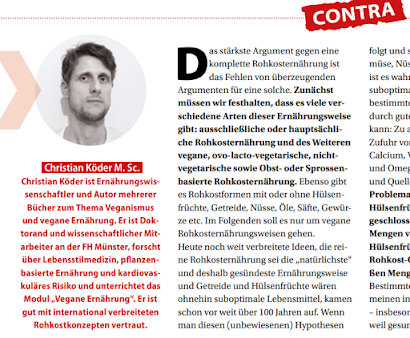

Published on August 15, 2020 04:10
August 13, 2020
Buchkapitel: Nachhaltigkeit veganer Ernährungsweisen
Ein Buchkapitel von mir in der neuen (zweiten) Auflage des Buchs "Vegane Ernährung" im Haupt Verlag. Im Kapitel geht es um Nachhaltigkeit nicht nur im Sinne von Umweltfreundlichkeit, sondern um einen weitergefassten Nachhaltigkeitsbegriff in sechs "Dimensionen": Gesellschaft, Gesundheit, Umwelt, Wirtschaft, Kultur und Tierethik. Auf diese Weise wird das Nachhaltigkeitsprofil veganer Ernährungsweisen untersucht.
Ich hatte mich um ein weniger unappetitlich aussehendes Cover wie bei der ersten Auflage bemüht. Meine Vorschläge Fotos von Münsters bestem veganen Restaurant (meine Meinung), Bucks, zu verwenden - mit deren freundlicher Unterstützung - konnte ich nicht durchsetzen, aber das Cover-Bild oben sieht schon mal viel besser aus als die erste Auflage (meine Meinung).

Ich bin mir nicht sicher, ob hier die Seitenzahlen noch aktuell sind. Mir liegt im Moment keine Ausgabe der finalen Version des Buchs vor. Hier fehlt auch noch ein "n" in der Kapitelüberschrift.

...
 ...
...
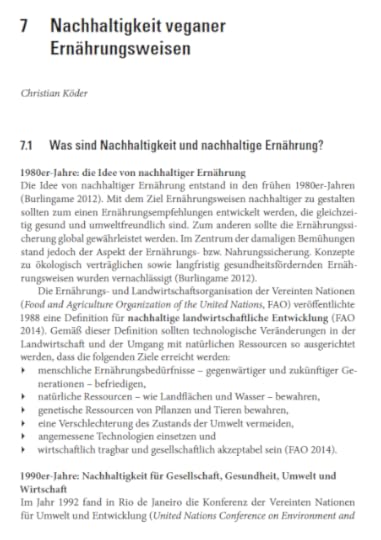 Ich bin natürlich nur für mein eigenes Kapitel verantwortlich. Im Abschnitt zum gegenwärtige massenhaften Aussterben von Spezies hatte ich diese kurze Anmerkung: "Ein Atomkrieg würde das Artensterben weiter eskalieren (Ceballos et al. 2017)." Diese wurde vom Editor des Verlags für übertrieben gehalten. Dass ein Atomkrieg eine extreme Gefahr für fast alle Lebewesen darstellen würde, ist klar. Ich hoffe, der Verlag behält recht und der tatsächliche Einsatz von Atomwaffen bleibt nach wir vor etwas sehr Absurdes, das vollkommen undenkbar ist. Ich hoffe, ich behalte - diesmal, anders als bei "Die nächste Pandemie kommt irgendwann" - unrecht.
Ich bin natürlich nur für mein eigenes Kapitel verantwortlich. Im Abschnitt zum gegenwärtige massenhaften Aussterben von Spezies hatte ich diese kurze Anmerkung: "Ein Atomkrieg würde das Artensterben weiter eskalieren (Ceballos et al. 2017)." Diese wurde vom Editor des Verlags für übertrieben gehalten. Dass ein Atomkrieg eine extreme Gefahr für fast alle Lebewesen darstellen würde, ist klar. Ich hoffe, der Verlag behält recht und der tatsächliche Einsatz von Atomwaffen bleibt nach wir vor etwas sehr Absurdes, das vollkommen undenkbar ist. Ich hoffe, ich behalte - diesmal, anders als bei "Die nächste Pandemie kommt irgendwann" - unrecht.
Published on August 13, 2020 09:46
August 2, 2020
Was Moondog a vegetarian?
 One of my agents has pointed me to this song by Moondog: Enough about human rights (03:37 min; see the lyrics below).
One of my agents has pointed me to this song by Moondog: Enough about human rights (03:37 min; see the lyrics below).Moondog (1916-1999) was an American, blind, avant garde musician and composer extraordinaire, originally called Louis Thomas Hardin, and also known as the Viking of Sixth Avenue (referring to the corner of 53rd/54th and 6th Avenue, Manhattan, New York City, in the 1960s), ... also known as "the ultimate counter culture figure".
His biography, written by Robert Scotto, mentions the following, referring to the years 1943 to 1953 in New York City: "[...] eating in was usually confined to porridge in the morning. His diet when he dined out consisted mainly of raw vegetables, fruit, and black bread." Regarding the years 1960 to 1969 the book states: "His stews became famous (fresh meat and vegetables only), his strong coffee (brewed by boiling water in a can with the beans) a necessity everywhere he went. [...]
[...] he roasted a large turkey, with stuffing and vegetables. [...]He hunted (with an arrow tied by string to the bow) and fished."Regarding his time before moving to Germany (so, around mid-1970s) the book states: "Another uncomfortable thing about living with Moondog was that he didn’t pick up after himself or know how or bother to throw out the trash, so I spent some time cleaning up the fast food he brought to his room, like empty boxes from Dunkin’ Donuts and half-eaten bones from Kentucky Fried Chicken."... And regarding the years 1986 to 1999 (Germany): "Moondog had always enjoyed robust health and an even more robust appetite, despite his risk-taking. In 1986, though, he learned that he had diabetes and would have to be less casual about his diet. No more cupcake at midday! He underestimated the seriousness of his condition, which led to his decline and death. But energy drove him, not ego; it was not in his flight plan to land yet. He rarely cancelled engagements, even when travel became harder on him. His first reaction to the news was to cut his sugar intake (even in his beloved coffee) and get to work. [...]
[...] what others called his odd habits: his sewing, plowing, hunting, writing."
The book also states that his 1992 album "Elpmas" contains "animal rights protest", and that he has written "a couple [of songs] on animal rights (“Pigmy [Pig],” “Enough about Human Rights,” “Aska Me”)" - all of which are on the album "H'art songs". However, "Aska me" and "Pigmy pig" do not contain any lyrics that I would file under animal rights. "Pigmy pig" does contain the following more or less cryptic lyrics:
"All you herbivorians, reapers to adore,if the only food were meat, you would eat no more.
All you carnivorians, butchers to adore,
if the only food were plant, you would eat no more.
All you omnivorians, waging total war,
if the only food were none, you would eat no more.
All the pigmy edibles wish you pigmies well:
'Eat your way to heaven, or eat your way to hell!'"
Anyway, below are the lyrics to Moondog's song "Enough about human rights". This song was originally published in Germany in 1978 on the album "H'art songs". The song is almost entirely about different animals' rights except that he kind of ruins the song by adding the idea of "germ rights" and "plant rights". The lyrics that you can find online seem to slightly differ from what he actually sings. I don't know if printed lyrics were included in the original "H'art songs" LP.

Enough about Human RightsEnough about human rightsWhat about whale rights? What about snail rights?
What about seal rights? What about eel rights?
What about coon rights? What about loon rights?
What about wolf [sounds like "ant"] rights? What about, what about, what about,
What about moose rights? What about goose rights?
What about lark rights? What about shark rights?
What about fox rights? What about ox rights?
What about mole [sounds like "hog"] rights? What about, what about, what about,
What about goat rights? What about stoat rights?
What about pike rigths? What about shrike rights?
What about hare rights? What about bear rights?What about plant rights?
What about ape rights?
Enough about human rights
What about hog rights? What about frog rights?
What about kite rights? What about mite rights?
What about bee rights? What about flea rights?What about ant stork rights? What about, what about, what about,
What about bat [sounds like "plant"?] rights? What about gnat rights?
What about mouse rights? What about louse [?] right?
What about cat rights? What about rat rights?
What about hawk rights? What about, what about, what about,
What about bug rights? What about slug rights?
What about bass rights? What about ass rights?
What about worm rights? What about germ rights?
What about [sounds like "pork"] rights?
What about plant rights?
Moodog moved to New York City from the American Midwest in the early 1943, i.e. during World War 2. In 1972 he moved from New York City to Candor, New York State (where he had a country house). In 1974 Moondog moved from the United States to Germany. Much of his time in Germany he lived in the town of Münster, Northwest Germany, where he died in 1999 (according to Wikipedia, from heart failure). He is buried at the Zentralfriedhof (central cemetary) and at his grave there is a sculpture made after Moondog's death mask (see below). However, he is not currently listed as one of the "famous people" buried at the cemetary on the cemetary's website (2 Aug 2020). I once was at that cemetary, looking for his grave, unprepared, and it was pissing down as the English say, and I didn't find the grave. I'll probably have another look soon.
According to Wikipedia, Moondog had adopted this name in 1947 in honour of a dog "who used to howl at the moon more than any dog I knew of". [The reference given is: Colin Larkin, ed. (1997). The Virgin Encyclopedia of Popular Music (Concise ed.). Virgin Books. pp. 869–870. ISBN 1-85227-745-9.]

Published on August 02, 2020 06:50
July 21, 2020
Entrevista para la Asociación Vida Sana (Barcelona)
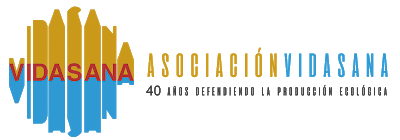
Muchas gracias a Pablo Bolaño por entrevistarme para la Asociación Vida Sana (Barcelona) y El Ecomensajero Digital. La entrevista se trata de mi nuevo libro Nutrición para bebés veganos (alimentación complementaria de 4 a 12 meses) y otros temas interesantes que conmueven todo el mundo.
Puedes hacer clic en este enlace para leer la entrevista o simplemente leer la entrevista a continuación.

Si te gusta la entrevista, por favor compártela con tus amigos, conocidos, enemigos y los líderes políticos más importantes del mundo. →
-¿Por qué crees que es necesario?-Creo que el libro puede ser muy útil porque para los padres veganos a los que les es difícil encontrar información fiable sobre este tema. Seguramente, se puede encontrar mucha información sobre cualquier cosa en Internet, pero creo que no hay otros libros sobre este tema específico, es decir, la alimentación complementaria para bebés veganos y un libro escrito por un científico en nutrición. Muchas pautas científicas o médicas recomiendan que los padres veganos deberían recibir un asesoramiento dietético especial, para que puedan diseñar bien la dieta de su bebé. Pero no hay muchos nutricionistas o médicos que puedan ofrecer este tipo de asesoramiento, es decir, un asesoramiento sobre nutrición vegana para bebés basado en la ciencia.
“Estoy completamente de acuerdo: un bebé vegano debe ser amamantado por su madre. En este sentido es muy importante que la madre vegana que amamanta tenga una ingesta suficiente de todos los nutrientes esenciales, porque la ingesta de nutrientes de la madre afectará al contenido de nutrientes en su leche materna. El nutriente más importante de mencionar para los veganos es, por supuesto, la vitamina B12. Las mujeres veganas que amamantan deberían tomar un suplemento diario de esta vitamina”
CADA VEZ, MÁS VEGANOS -¿Hay cada vez más bebés veganos?-Creo que sí. El veganismo y las dietas veganas se han vuelto mucho más populares en la última década, pero especialmente en los últimos cinco años. En la década de 1990, cuando yo me hice vegano, no había muchos bebés veganos. Ahora, casi todas las personas que conozco me dicen que conocen a alguien que es vegana o vegano y que tiene un bebé vegano o un niño vegano.
-¿Un bebé vegano debería ser amamantado por su madre? ¿Una opción contraria no sería una opción demasiado extrema?-Estoy completamente de acuerdo: un bebé vegano debe ser amamantado por su madre. En este sentido es muy importante que la madre vegana que amamanta tenga una ingesta suficiente de todos los nutrientes esenciales, porque la ingesta de nutrientes de la madre afectará al contenido de nutrientes en su leche materna. El nutriente más importante de mencionar para los veganos es, por supuesto, la vitamina B12. Las mujeres veganas que amamantan deberían tomar un suplemento diario de esta vitamina. Mi libro también contiene recomendaciones para las madres que amamantan y explica a qué nutrientes deberían prestar atención. Es bastante fácil si tienes este tipo de lista con recomendaciones. Por lo menos, eso es lo que espero. Si por alguna razón no es posible amamantar, el bebé debe recibir fórmula infantil (no casera) en lugar de leche materna. En cuanto a la “opción muy extrema” tienes razón: en realidad hay algunas personas que piensan que la leche materna humana no es vegana, porque los humanos biológicamente somos animales, por lo que la leche materna sería un “alimento de origen animal”. Esto de verdad me parece extremo. Sin embargo, el movimiento vegano tiene una larga historia, desde sus inicios, de recomendar explícitamente la lactancia materna, y se sabe (de estudios) que las madres veganas tienen más probabilidades de amamantar a su bebé durante el tiempo recomendado en comparación con el resto de la población. Todos los bebés deben consumir solo leche materna hasta por lo menos los 4 meses. La Organización Mundial de la Salud recomienda 6 meses. Lo ideal sería que el bebé siguiera siendo amamantado hasta los dos años (o más) junto con su dieta habitual.
NO EN TODO EL PLANETA-¿Está ocurriendo en todo el planeta la tendencia vegana? ¿Por qué?-Me parece que la tendencia vegana al alza no incluye todo el planeta, pero probablemente sí la mayoría de las regiones del mundo. Por lo que sé, algunas regiones muy pobres, incluidos algunos países africanos, y algunos lugares muy aislados, como Corea del Norte, están excluidos de esta tendencia. En realidad, no sé cómo surgió esta tendencia. Pero creo que tiene algo que ver simplemente con un cambio en las generaciones, y seguramente tiene mucho que ver con muchas personas, de todas las edades, pero especialmente las personas más jóvenes que tienen una mente abierta acerca de ser “veganos a tiempo parcial” o “semi-veganos” o “casi veganos”. Muchas personas, tal vez la mayoría, parecen tener miedo o no les gusta adquirir un compromiso absoluto de hacerse 100% vegetarianas o 100% veganas.
-¿Hay otras teorías para ese tendencia alcista del veganismo?-Otra razón es que muchas personas han dedicado mucho tiempo a educar al público sobre este tema. Por ejemplo, recientemente ha habido mucha conciencia sobre el cambio climático, y ahora tenemos un problema enorme y muy obvio con el peligro de que los patógenos zoonóticos puedan causar pandemias. Tenemos un gran problema con la contaminación del aire y los problemas de salud que resultan de eso, también un gran problema con la contaminación del agua, y parece que hemos entrado en una nueva era de extinción masiva de especies. Además, nuestras sociedades tienen un enorme problema con la obesidad y la diabetes (pueden considerarse pandemias), las enfermedades del corazón y de los pulmones y el cáncer. Y todos estos problemas podrían mejorarse mucho si nuestra sociedad se mueve hacia una alimentación basada en plantas, quiere decir una dieta semi-vegana o vegana o algo parecido. La conciencia sobre esto está aumentando, seguramente también debido a la “revolución de Internet”.
STEFANO MANCUSO -Los libros de Stefano Mancuso demuestran que los vegetales son también sintientes. ¿Es un dilema para los veganos? -Esta idea no es nueva. En 1968, L. Ronald Hubbard, el fundador de Scientology, inventó el “Electrómetro Hubbard”, que creía que podía probar que los tomates gritan cuando se cortan. Pero, en el caso de Stefano Mancuso, el asunto es que él usa palabras como inteligencia y conciencia con un significado diferente. Casi nadie piensa que cortar la cabeza de un animal es lo mismo, moralmente, que cortar una planta. Las plantas no tienen cerebro ni ningún otro sistema nervioso central. De hecho, las plantas no tienen ningún órgano. (Stefano Mancuso escribe: “Nunca afirmamos que las plantas tengan neuronas reales […]”.) [https://www.ncbi.nlm.nih.gov/pmc/articles/PMC7202056/ ] Pero incluso si las plantas pudieran sentir dolor, esta sería una muy buena razón para comer menos carne y menos alimentos de origen animal… y así dejar de desperdiciar cereales y legumbres que se usan para alimentar a los animales de granja. Stefano Mancuso dice muchas cosas: por ejemplo, que el 99.7% de la biomasa terrestre son plantas, lo que es muy exagerado. [Y él lo sabe. https://www.ncbi.nlm.nih.gov/pmc/articles/PMC7202056/ ] Dudo que incluso Stefano Mancuso crea que las plantas pueden sufrir de manera similar a los animales y, que yo sepa, no afirma para nada que las plantas puedan sufrir o sentir placer. Mancuso usa las palabras “conciencia” e “inteligencia” con unas definiciones muy abiertas: por ejemplo, dice que las plantas tienen “inteligencia” porque son “capaces de resolver problemas”. Una planta puede girar hacia la luz, un ejemplo de resolver un problema. Mancuso también se refiere al físico Michio Kaku, quien afirma que un termostato tiene “conciencia” (porque puede “sentir” la temperatura). E incluso Mancuso (como Kaku) dice que las plantas tienen “inteligencia” pero que esta inteligencia es diferente de la inteligencia en los animales.
B12 -¿Hay veganos que trivializan la necesidad de B12 con oscuras consecuencias? ¿Cuál es tu opinión al respecto?-Sí, desafortunadamente hay veganos (y no veganos) de este tipo. Cuando vivía en Chile, hace más de diez años, muchos veganos se burlaban de mí por decir que los veganos deben prestar atención a la vitamina B12. Fue muy similar en Brasil. Y puede ser que siga siendo muy similar en muchas partes del mundo. En la década de 1990 y principios de 2000, la mayoría de los veganos se burlaron de la idea de tomar un suplemento de B12, incluso en Londres, la “ciudad natal del veganismo”. Este fue un gran fracaso del movimiento vegano. En realidad, se sabe desde la década de 1950, a partir de estudios con veganos, que los veganos deben tomar suplementos de vitamina B12 o consumir alimentos enriquecidos. Mi opinión es que la información incorrecta que algunas organizaciones veganas promueven, a sabiendas, es muy peligrosa y en realidad eso me parece criminal. Una deficiencia de vitamina B12 puede ser muy peligrosa, especialmente para los bebés, y todas las personas deberían saber eso. Las organizaciones que promueven el veganismo deben ofrecer información (basada en la ciencia) sobre la vitamina B12. Si no lo hacen, no les des tu dinero.
Pablo Bolaño
Publicado en El Ecomensajero Digital (15 de Julio de 2020)
La versión Kindle (ebook) del libro
https://www.amazon.es/Nutrici%C3%B3n-para-beb%C3%A9s-veganos-complementaria/dp/B08CPG39Y9
Sobre su anterior libro, también sobre veganismo
https://www.amazon.es/Nutrici%C3%B3n-vegana-Separando-evidencia-creencia/dp/1540853772
Published on July 21, 2020 07:33
July 12, 2020
When the Nike has come: Nyjah 2 is leather-free
Summary: the name is "Nike SB Nyjah Free 2". The upper is rubber and mesh. The shoes are leather-free. Leather-free does not necessarily mean 100% or 1000% vegan. But investing too much time thinking about the space between 99% and 100% vegan does, as more or less brilliant minds before me have pointed out, seem like a big waste of time. Time we could make better use of by trying to learn backside noseblunt slides, or by going underground for animals liberation (whoa!), or whatever tickles your fancy.
Says the Nike website:
The Nike SB Nyjah Free 2 is a sequel worthy of its predecessor. Inspired by the iconic Nike Air Zoom Spiridon, the original rubber design has been updated with mesh panels to help your feet stay cool through your hottest skate sessions.
Breathable UpdateOriginal, 360-degree rubber upper has been updated with mesh panels for breathability where you need it most. The rubber and mesh are fused together for extra durability.
Durable LacingGhillie loops hug your foot from bottom to top while their unique design helps your laces last longer. [If this works, definitely a very good idea. I'm not fussed as to why they call the lace loops "Ghillie" loops. Probably some millenial military fetish thing.]
Excellent GripRubber outsole has deep grooves that expand and contract as your foot moves. It gives you a broken-in feel right out of the box. [If this is true, éS beware.]
From the VaultDesign details, from the ghillie loops to the placement of the mesh, was inspired by the 1997 Nike Spiridon. [irrelevant]
More Benefits- Internal, 3/4-length sleeve creates a sock-like fit. [Does that mean the heel will slip out?]
Product Details- Foam sockliner- "II" is printed on heel pull tab- "Nyjah" is printed on tongue pull tab- Not intended for use as Personal Protective Equipment (PPE)"
Shown: Black/Metallic Silver/Black/Sport Red
Style: BV2078-002


---
Shown: Black/Black/Black/WhiteStyle: BV2078-001
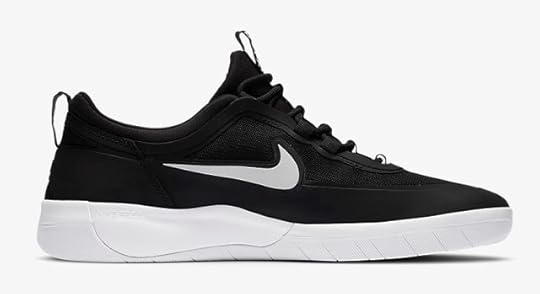

---Shown: Summit White/Summit White/Summit White/BlackStyle: BV2078-100

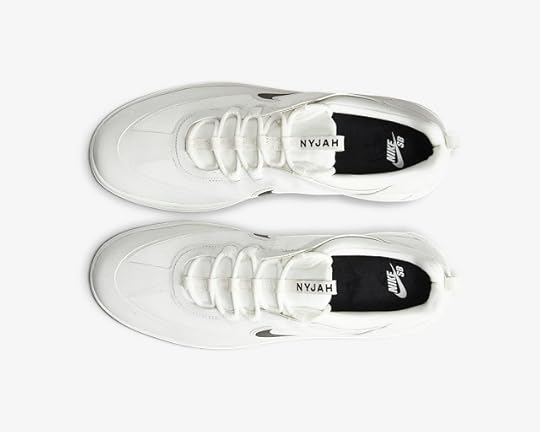
---
P.S.: If you don't know who this Nyjah is... You know Justin Bieber's friend. The kid who grew up as a (dietary) vegan (now a moderate carnivore). The guy who won the Olympics. I would really like to see Bieber and Nyjah become animal rights vegans, You know, do something with your fame.
Published on July 12, 2020 14:00
Nutrición para bebés veganos: el libro

Queridas personas del mundo de habla hispana,
queridos pediatras y médicos de familia,
queridos padres,
es posible que ya hayan escuchado (debido a la fama mundial que disfruto) que he publicado un nuevo libro sobre nutrición vegana para bebés.
Como pueden ver arriba, el título del libro es:
Nutrición para bebés veganos
Alimentación complementaria de 4 a 12 meses
Si encuentran un poco extraño el término "alimentación complementaria", está bien. Pero es el término oficialmente correcto. Lean más sobre esto, si quieren, en el sitio web de la Organización Mundial de la Salud.Para aquellos de ustedes que nunca leerán el libro: asegúrese de que tanto la madre vegana que amamanta como el bebé vegano reciban suficiente vitamina B12. La madre puede tomar aproximadamente 25 µg de vitamina B12 por día, y el bebé puede recibir aproximadamente 5 µg de vitamina B12 por día, a partir de los 6 meses en adelante.
Regresando al tema: quiero asegurarme de que los bebés veganos obtengan todo lo que necesitan.
Entonces, aquí pueden leer una descripción de lo que trata el libro... Puede parecer, para algunos, un poco demasiado dramático, pero igualmente, tener que leer nuevos artículos sobre unos bebés veganos con terribles deficiencias es demasiado dramatico (incluso si son excepciones).
→
Published on July 12, 2020 13:17



